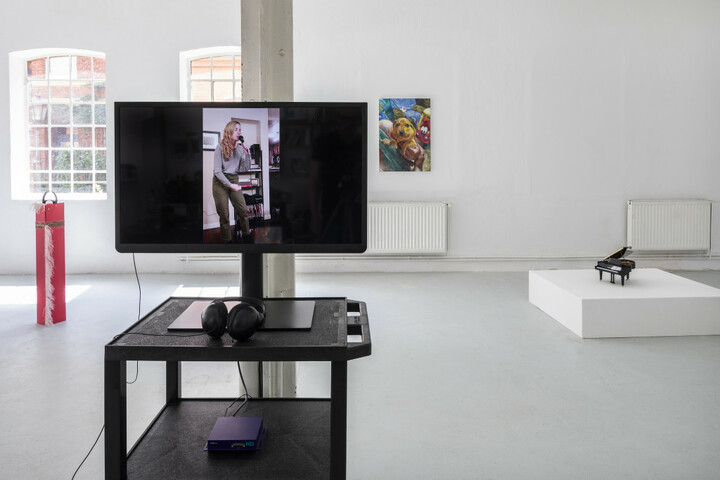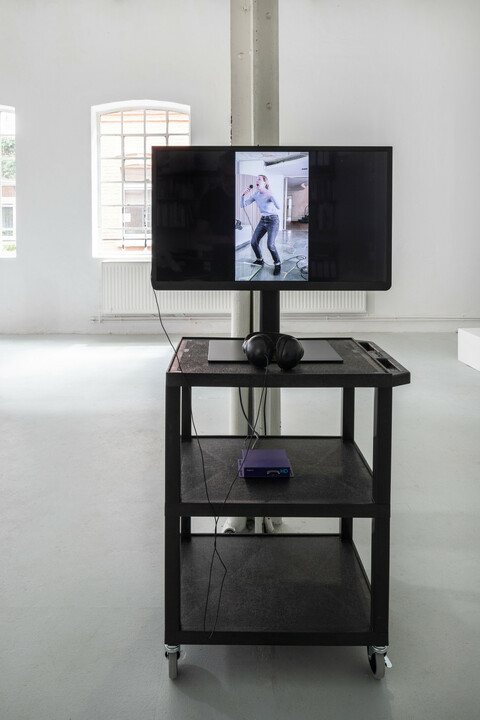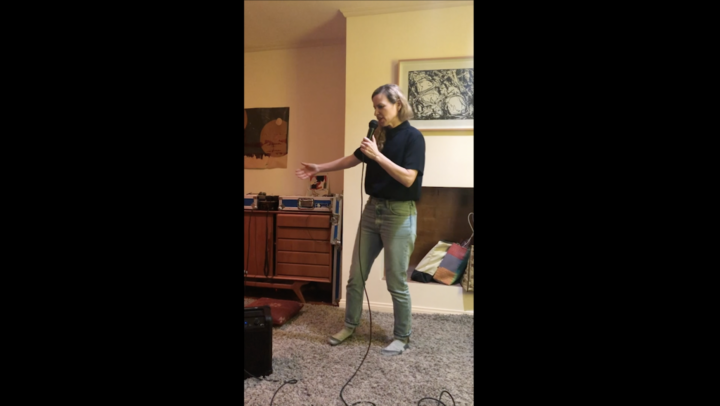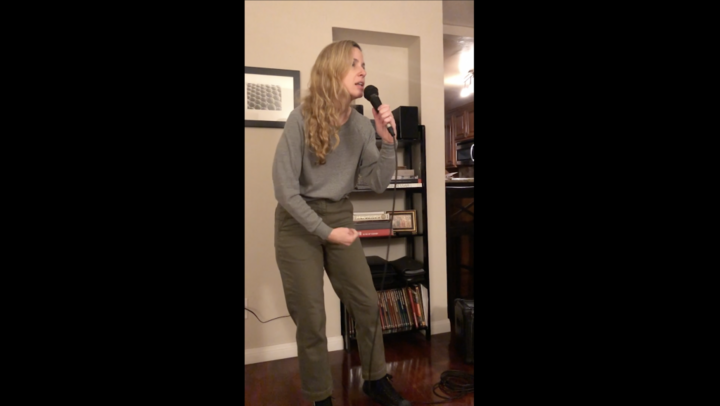Halle Für Kunst Lüneburg
Halle Für Kunst Lüneburg
Halle Für Kunst Lüneburg


Stand Up, 2019
Single channel video, monitor, A/V cart
Single channel video, monitor, A/V cart

Stand Up, 2019 (still)
Single channel video, monitor, A/V cart
Single channel video, monitor, A/V cart

Stand Up, 2019 (still)
Single channel video, monitor, A/V cart
Single channel video, monitor, A/V cart
Artists: Morgan Bassichis, Vanessa Conte, Hamishi Farah, James Krone, D'Ette Nogle, Nadia Perlov, Kameelah Janan Rasheed
When there is no laughing matter, laughter matters - Sarah Ahmed gives the readers this ambiguous mantra in her life guide Living a Feminist Life. The aim of this humorous didactic piece is the successful transformation of your readership into the figure of “Killjoy”, a feminist “spoiler of fun” who is composed of precisely those prejudices that are brought towards her - and with these prejudices drives her fun. [1]
Lauren Berlant also observes the reflection of life realities in cultural genres in her affect-theoretical analysis of late capitalist societies. As a "situation tragedy", Berlant describes the emerging psychological mode of affective adjustment from humorous, optimistic self-regulation in view of the structural experience of social, political and ecological crises and existing ideas of social advancement opportunities. [2] This hybrid, all too real genre is related to the entertaining situation comedy and thus also to the return of precarious situations and the limited reaction to them based on a given set of options for action. While Henri Bergson localized comedy in his humor theory in moments of lack of social "elasticity" - in which the adaptation to socio-economic conditions does not succeed and a supposedly general human-organic "mechanics" emerges [3] - contemporary approaches rather emphasize the normative effects of these fundamentally (Anti) social practice based on the performance of stereotyping representations, the marking of belonging to social groups and psychological influence. [4]
Playing with assigned and fixed roles, within which only certain improvisations can be carried out, sound out the artistic practices gathered in the exhibition in visual, verbal and theatrical tilting figures. Along the boundaries of humor, they shed light on the forms in which it often becomes an arena of negotiation processes for political representation.
James Krone, who in his practice often recycles gestures of modernity that have been tried and tested in art history, leaves Somebody Else in his work (2019) based on one of the great genres of comedy - pantomime - representation mechanisms exhaustively run into the void. In the video sculpture, which includes an automated miniature piano in addition to the film, Krone himself embodies the figure of the sad and mute clown Pierrot, whose play of gestures as an expression of a supposedly universally understandable non-verbal language founded the art form of pantomime. The tragedy of Pierrot, who was often staged as an outsider and artist figure alienated from the world in Romanticism and Modernism, is condensed in Krones' fragile video loop through the compulsion to always use the same, semiotic legible expressions. In the increasing drifting apart of different signifiers - body expression, cheap joke article (the miniature piano),
In her video work Pitchy 1, 2, 3, 4 (2020), Morgan Bassichis uses the improvisation technique already laid out in the Commedia dell'arte and refined in contemporary stand-up comedy to liquefy social scripts. Set up as a four-act interview that promises the audience a voyeuristic sequence of “coming-outs” [5] behind the scenes, we see Bassichi's comedian alter ego bombarded in intimate rooms with serious questions from an always invisible interviewer. Bassichi's virtuoso transforms questions about the biological and artistic "family" into spontaneous vocal interludes that evade identity and meaning. In Bassichi's orchestration, a musical call-and-response Score, in which they themselves set the tone, identity is presented as a relational situation that is constantly re-established.
Acts of speech also form the starting point for the poster series How To Suffer Politely (and Other Etiquette) (2014/21) by Kameelah Janan Rasheed. In this she gathers and varies various idioms that circulate in US-American parlance, which admonish a "sense of humor" and "lightness" despite the experience of suffering. Inflated to poster size, highlighted with signal color and pervading the interior and exterior of the Hall for Art, Rasheed transforms the practice of reading into a public-corporeal act. With this shift, she distills the mechanisms of a social “guidance system” in which humor is a coping strategy becomes part of a normalization of systemic oppression.
Hamishi Farah's practice also revolves around "strange alibis" [6] and practices of representation and imitation. With Untitled (2021) Farah slips into the role of the British painter Merlin Carpenter, whose artistic practice combines the appropriation of existing artistic gestures with in-jokes in the service of a critique of the art system. The scrawly painted letter of apology, the exhibition Children of the Projects, which works on Carpenters with stereotypical depictions of Afro-American youth (2003) as well as their further discursive processing by art magazines and gallerists, reads itself like a press release from the painter Carpenters' next project that will exploit everything. Without figurative representation, Farah creates a satirical group portrait that reduces the painter and his network themselves to representatives of a strategically acting art world and continues its transactional logic in the medium of painting.
In D'Ette Nogel's video work Stand up (2019) it is the performance of a professional comedian that is examined in its social dimension through personnel and spatial shifts. In the living rooms of various friends, Nogle borrows the role of American stand-up comedian Louis CK, who lost his show in 2017 due to sexual abuse in the form of public masturbation in front of female comedians. A comic situation arises in the discrepancy between Nogle's (gender identifiable) embodiment, the domestic environment and the vulgar-macho stage show, which always self-ironically laments the restriction of one's own privileges due to changing socio-political norms.[7]
Nadia Perlov's sculptures are also tricksters who move through the room like seemingly harmless play figures and occupy their fields: exhibited on white plinths, some of Perlov's squeaky-colored, plushy objects are reminiscent of poor versions of desirable luxury handbags from boutiques, while the vertical sculptures rather allow associations with miniature models of a colorful Disney skyline. Tony, Jenny, Renata and Roxanne (2021) anticipate their future multiplication through varying form, size and details and seem to become gimmick-like representatives: inside their potentially human agents of a capitalist system. Perlov uses this humorous abbreviation and metonymy to negotiate “soft” manifestations of imperial techniques as they emerge in globalized architectures, goods and pop-cultural surfaces. [8]
Visual genre of objectification also form the starting point for Vanessa Conte's work Stuffed (2021). Based on the explicit representations of the so-called hentai, pornographic mangas, and the narrative form of the comic, Vanessa Conte lets her archetypal female characters stumble into brutal, clearly ambiguous everyday scenes. In these sequences, balloon-like breasts and buttocks are worked on and deformed in places of entertainment and consumption by female allies acting together. Slapstick-like moments arise in particular in the clash with the numerous accessories (high heels, roller skates, tennis rackets, etc.) of the opponents, in which women's bodies and converted instruments of torture merge into an erotic grotesque and seem to compete with one another in their materiality. With the imagination of this female dominated consumer world,[9] of a patriarchal “pharmacopornographic” system. [10] At the same time, Conte destabilizes precisely that internalized male, hetero-normative gaze and occasionally mobilizes a queer reading as well as non-normative sexual practices (such as fetish and BDSM), in which logics of superiority and inferiority in playful - and quite comical - transgression to be overcome.
[1] Sarah Ahmed, Living a Feminist Life, Duke University Press 2017, pp. 261f.
[2] Lauren Berlant, Cruel Optimism, Duke University Press 2011, p. 11.
[3] Henri Bergson, Laughter. An Essay on the Meaning of the Comic, Rockwill: Arc Manor 2008, p. 13.
[4] Matthew Kotzen, The Normativity of Humor, in: Philosophical Issues 25 (2015), pp. 396-414; Kobena Mercer: Carnivalesque and Grotesque. What Bakhtin's Laughter Tells Us about Art and Culture, in: Angela Rosenthal (ed.), No Laughing Matter. Visual Humor in Ideas of Race, Nationality, and Ethnicity , pp. 8/9; Jessyka Finley, Black Women's Satire as Postmodern Performance, in: Studies in American Humor, Vol. 2, No. 2, Special Issue: American Satire and the Postmodern Condition, pp. 236-265.
[5] See Rick McCormick, Coming out as Jewish. To be or not to be, 1942, in: Ders., Sex, Politics, and Comedy. The Transnational Cinema of Ernst Lubitsch, Indiana University Press 2020, p. 299.
[6] William Cheng, Taking Back the Laugh: Comedic Alibis and Funny Fails, in: Comedy has Issues, in: Critiqual Inquiry 43 (Winter 2017), p. 528.
[7] See Sianne Ngai, Our Aesthetic Categories. Zany, Cute, Interesting, Cambridge: Harvard University Press 2011, pp. 208f.
[8] Cf. Sianne Ngai, Theory of the Gimmick, in: Comedy has Issues, in: Critiqual Inquiry 43 (Winter 2017), p. 466f.
[9] Tiqqin, Preliminary Materials for a Theory of the Young-Girl, Los Angeles: Semiotexte, p. 88.
[10] Paul P. Preciado, Sex, Drugs and Biopolitics in the Pharmacopornographic era, New York: The Feminist Press 2013.
- curated by Hendrike Nagel and Elena Setzer
The annual program of the Halle für Kunst Lüneburg is generously funded by the State of Lower Saxony, the Sparkassenstiftung Lüneburg and the Hanseatic City of Lüneburg. The mediation program is made possible by the state of Lower Saxony.
The exhibition is funded by the Lower Saxony Sparkasse Foundation, the Lüneburg Landscape Association and the Hanseatic City of Lüneburg.